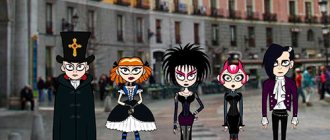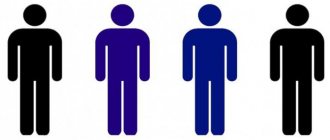Greetings, friends!
People tend to adopt moral values, habits and behavior patterns from those around them. In addition, they unite in groups, isolate themselves, trying to spend more time with those whose views on life are closest to them. Thanks to this, subcultures are formed - large groups of people united by common tastes, values, interests, views, aspirations or ideas. Today we will analyze in detail what subcultures are, what characteristics they have and what they are, and also consider several examples.
What is a subculture?
A subculture is a separate part of the main (dominant) culture, which stands out strongly against the general background. It can be formed on the basis of moral values, religious views, traditions, customs and other sociocultural characteristics. The most obvious example of a subculture is youth movements that unite fans of certain styles of music or a significant cultural phenomenon (for example, the works of Tolkien or Lovecraft).
To fully understand the term “subculture”, let’s also define the concept of “culture”. In simple terms, culture is the totality of all material and intangible values created by humanity. At the same time, we can talk about one universal culture, or we can distinguish the cultures of individual countries and peoples. In any case, it implies a set of universal values accepted by all representatives of a particular people, regardless of age, social status and other factors.
Most modern subcultures are youth subcultures, since teenagers and young adults are characterized by a low level of conformism (what is this?) and tolerance to the moral values that society imposes.
Countercultures are an important type of subculture. This is the name given to subcultures that are completely built on the denial of traditional values for a given society. Some authors believe that the term “counterculture” is appropriate whenever the primary element of identifying a subculture is based on opposition to the dominant culture.
Youth as a socio-psychological group
To consider the problems of youth, it is necessary to imagine what youth is and how it differs from other social groups.
Therefore, the first chapter is devoted to the analysis of individual and personal characteristics characteristic of young people, as well as patterns of assimilation of norms, values, behavior characteristic of society, various organized and unorganized groups that influence the individual.
For a long time in Russian sociology, adolescents were not considered as a separate socio-demographic group.
The identification of such a group did not fit into existing ideas about the class structure of society and contradicted the official ideological doctrine of its socio-political unity.
One of the first definitions of the term “youth” was given by V.T. Lisovsky in 1968: “the younger generation of people who are going through the stage of socialization and learning (and have already learned in older age) educational, professional, cultural and other social functions; depending on specific historical conditions, age criteria for youth can vary from 16 to 30 years.” A more complete definition was given later by I.S. Kon: “Youth is a socio-demographic group characterized by a set of age characteristics, characteristics of social status and socio-psychological characteristics determined by both.” Youth as a specific stage, a stage of the life cycle, is biologically universal, but its specific age framework, associated social status and socio-psychological characteristics are social and historical in nature and depend on the social system, culture and patterns of socialization inherent in society.”
Today, scientists define youth as a socio-demographic group of society, characterized by a number of features, characteristics of social status and determined by certain socio-psychological characteristics determined by the level of socio-economic, cultural development, and characteristics of socialization in Russian society.
Youth is the path to the future that a person chooses himself. Choosing the future and planning it is a characteristic feature of young age; it would not be so attractive if a person knew in advance what would happen to him tomorrow, in a month, in a year.
In the psychology of old age, youth is characterized as a period of formation of a stable system of values, the formation of self-awareness and the formation of a person’s social status. The consciousness of a young person has a special sensitivity, the ability to process and assimilate a huge flow of information. At this time, critical thinking develops, the desire to make one’s own assessment of various phenomena, the search for arguments, and original thinking. At the same time, at this age there are still some attitudes and stereotypes inherited from the previous generation. This is due to the fact that the period of active activity confronts the young man with the limited nature of practical, creative activity, and the incomplete inclusion of the young man in the system of social relations. Therefore, in the behavior of young people there is an amazing combination of contradictory qualities and characteristics: the desire for identification and isolation, conformism and negativism, imitation and rejection of generally accepted norms, the desire for communication and isolation, isolation from the outside world. The instability and inconsistency of youthful consciousness affects many forms of behavior and activity of the individual. The consciousness of young people is determined by a number of objective circumstances.
Firstly, in modern conditions the process of socialization has become more complex and lengthy, and, accordingly, the criteria for social maturity have become different. They are determined not only by entering into an independent working life, but also by obtaining an education, training in a profession, real political and civil rights, and material independence from parents. The influence of these factors is not simultaneous and unambiguous in different social groups, therefore, a teenager’s assimilation of the system of social roles of adults is contradictory. He can be responsible and serious in one area and feel like a teenager in another.
Secondly, the formation of social maturity of young people occurs under the influence of many relatively independent factors: Family, school, work collective, media, youth organizations and spontaneous groups. This multiplicity of institutions and mechanisms of socialization is not a rigid hierarchical system; each of them performs its own specific functions in the development of the individual.
Youth is the time when everyone must determine their own destiny, find the only true path of life leading to success, which will allow them to realize their abilities and talents to the maximum. This period is associated with a painfully difficult process of self-knowledge, finding one’s “I”. A person must determine the limits of his actual abilities in order to understand what he is capable of in order to declare himself in society. On the other hand, at the same time, he must form the most accurate picture of the world around him, systematize its value orientations, political, moral, aesthetic views. Life gives a young person the need to make a number of critical decisions in the absence of life experience. Choosing a profession, choosing a partner, choosing friends - this is not a complete list of problems, certain decisions that largely shape the future way of life.
How did the term come about?
The term “subculture” is derived from the Latin words sub (under) and cultura (culture). Therefore, in the Russian language the word “subculture” can be used on an equal basis with it. This term is used in political science, sociology, philosophy, anthropology and many other sciences, in which it can be interpreted somewhat differently. It is important not to confuse subcultures with youth communities consisting of young people with common interests.
This concept was introduced by the American sociologist David Riesman. He gave it the following definition: a subculture is a certain social group that demonstratively chooses moral values, an appearance style and manners that do not correspond to the generally accepted ones. This phenomenon was later studied by British sociologist Dick Habdige. He noted that subcultures include people united by common tastes and at the same time dissatisfied with the norms accepted in their society.
Interestingly, in the 20th century, many authors used alternative terms to refer to this phenomenon. Thus, the French sociologist Michel Maffesoli calls youth subcultures “urban tribes,” and the Soviet biologist Viktor Dolnik uses the term “clubs.” In the USSR, the concept of “informal youth associations” was widely used, and their representatives were called “informals.” Around the same time, the slang word “tusovka,” which is still popular today, appeared.
Youth subcultures as a factor of socialization
Youth subcultures are an effective and active factor of socialization. Previously, subcultures were always equated with groups of people with negatively deviant behavior. In this regard, more attention and research into subcultures was given by criminologists rather than psychologists, sociologists or cultural scientists. But over time, typologies of subcultures were created according to various criteria (70s of the 20th century) and it became obvious that not all subcultures are a factor of negative deviations.
- I share the theory of R.I. Zinurova and T.N. Guryanova, according to which people who are already asocially oriented come to asocial subcultures. In the corresponding subcultures, these people seek support for their asocial norms and values and the opportunity to realize them.
- Depending on the nature of the subculture (musical, virtual, political, etc.), there are different risks for its participants. For example, such as Internet addiction, drug addiction, alcoholism, indecent behavior, change of sexual orientation, androgyny, neglect of study, work, real communication, etc.
- At the same time, there are subcultures that stimulate positive deviant behavior. Creative subcultures often include people with positive deviations (artists, poets, inventors, musicians, researchers).
Summarizing all of the above, we can say that youth subcultures are not so much a factor in the formation of deviant behavior, but rather a development factor and a catalyst for deviations that an individual already has. And they can be both positive and negative. Behind the progress or regression of society there have always been people with deviations (positive or negative).
Signs of a subculture
In most cases, representatives of subcultures seek to emphasize their belonging to a particular movement. This is manifested in their habits, behavior, speech patterns and appearance. They listen to certain styles of music and often reject other styles, even if they do not have an aesthetic dislike for them.
Most subcultures are characterized by the presence of such elements as:
- special lifestyle and behavior;
- own set of moral values and views;
- characteristic features of appearance;
- nonconformism;
- low tolerance for universal values and high for values accepted within the movement.
Usually subcultures are apolitical, and their representatives emphasize their apoliticality. But it also happens that they adhere to certain political views, which they express in a rather harsh form. A subculture can be closed and strive to isolate itself from society as much as possible, or it can behave defiantly, demonstrating protest against accepted norms in society or some significant events. Many subcultures have their own press and public organizations.
Features of participation
The process of a young person’s involvement in the life of a subculture is implemented in 4 stages.
Self-determination within a subculture (personal identity)
The first stage is characterized by the destruction of previous values, attitudes and the adoption of the lifestyle and morality of a given subculture, a look at reality through the prism of the values and ideas prescribed in a particular group.
Group affiliation (“we”, “ours”, “ours”)
At this level, members of the subculture:
- exchange information about concerts, performers, music;
- share their impressions of books and song lyrics;
- they tell their first or new experience in trying drugs or other substances, as well as the experience of antisocial behavior, that is, a community of participants is cultivated.
Changes in appearance and leisure time
At the next stage, a person finds himself at some meetings and parties of all representatives of the informal movements of the city. Most often through friends. In these places:
- new acquaintances arise;
- the sense of community, agency and meaning is further enhanced.
At the same time, external changes in a person and changes in usual leisure time occur. Many subcultures require specific external changes. Sometimes these changes contradict the requirements of family or work, but if a person is very interested in a subculture, he will give preference to it.
A complete change in life and escape from reality
The fourth stage represents the transition of a subculture from a person’s hobby to everyday life and reality. Subcultural principles and norms permeate a person’s entire life. Often he gives up his name and chooses a pseudonym for virtual communication or a nickname for communicating at real parties.
At this same stage, disagreements may arise with peers, acquaintances from “pre-subcultural” life and relatives. Most often they are caused by a discrepancy in opinions and views regarding the ideology of a particular subculture. For example, if we are talking about a musical subculture, then there are different views on musical style. Sometimes it all ends:
- the departure of a subculture member from home;
- vagrancy;
- begging;
- wandering around friends or hangouts;
- leaving for “their own”.
Youth subcultures
Teenagers and young people always demonstrate nonconformity towards the older generation - this is inherent in human nature. Therefore, it is in the youth environment that new cultural movements usually arise, using the example of which it is most convenient to explain what a subculture is. It is important to understand that modern youth do not perceive work as a central part of their lives. Much more important to them is how they spend their leisure time.
Youth subcultures are characterized by the following features:
- use of slang;
- group conformism (the opinion of the “party” is taken as one’s own);
- a special style of clothing, and sometimes hairstyle;
- interest in certain types of art (for example, anime);
- characteristic type of behavior;
- the desire to emphasize one’s informality.
Youth subcultures are characterized by a surrogate character. Their representatives fill their lives with substitutes for real values. For example, they protest against the will of their parents, pretending to be independent , although they are not yet ready for an independent life. Quite often, protest against the norms of the older generation is expressed in smoking, drinking alcohol and drugs.
10 little-known subcultures that will surprise you
Renegades
Africa might seem like the last place you'd find heavy metal fans, but Botswana's leather-clad Renegades are defying all conventions and bringing heavy metal to desert towns.
These guys are tough to the core: their style is best described by the term "post-apocalyptic bikers", and living in the Kalahari Desert has made them much tougher than other famous metal bands.
Renegades love to ride big motorcycles and form their own bands. The band Skinflint from Botswana has achieved the greatest success, playing a unique brand of heavy metal with an admixture of African cultural themes.
Raggare
Swedes are known for their reserve and conservatism in both their clothing and lifestyle, but Raggare breaks this stereotype.
The Raggare are rockabilly styled, with high pompadour hairstyles, classic American cars, and their overall lifestyle is in stark contrast to the harsh reality around them.
Every year, thousands of Raggars gather in Westeros, also known as "the world's biggest and baddest car show." They gather there to compare cars and clothes and share their pride with their peers in the Nore Rebels movement.
Juggalos
Juggalos are the only subculture whose members can proudly call themselves clowns, as the entire subculture is associated with face painting, Faygo soda and the music of the Insane Clown Posse.
Juggalos are essentially studious students of the Insane Clown Posse, who can talk about dismembering someone with an ax in the first minute of their songs, and then start making references to God by the second.
These clown-faced hoodlums gather every year at an event called the Juggalo Jamboree to watch their favorite horror bands, get into a few fights, and join the decidedly weird subculture called the Juggalos.
Iraqi Emo Kids
In countries where there has been war for years, where people are dying and everything is turned upside down, there is something in common, and this “something” is called sadness.
When you are surrounded by a lot of sadness on all sides, it is impossible to ignore it. This is what the popular teen music subculture known as emo is based on. Sadness became part of their style.
This amazing subculture has even reached teenagers in Iraq. In Iraq's highly conservative institutions, "emo teens" are treated with extreme disdain because they often equate emos with homosexuals, so dressing like an emo is very dangerous there.
In 2012, dozens of emo teenagers were killed in Iraq by extremists who considered their clothing a direct insult to society.
Seapunk
The phenomenon known today as Seapunk was the first subculture of the 21st century, and like most viral trends, the subculture lasted exactly one minute. The Seapunk movement is believed to have started as a joke on Twitter, but quickly grew into a very large and fashionable music subculture, thanks in large part to artists such as Rihanna and Azealia Banks.
Everything in this subculture is somehow connected with water. They dye their hair turquoise, listen to music whose beats sound like they were recorded underwater, and wear '90s sportswear with a decidedly beachy vibe.
This largely club-based subculture is thought to have died out after its music and style were fully appropriated by major pop artists, but even today there are several underground clubs for Seapunk members.
Japanese Greasers
The Japanese love to take their subculture to extremes. They love to wear very glamorous outfits and use lots of accessories and other interesting visual elements to make a strong impression on others. So it's no surprise that, taking on the persona of the American Greasers, they went all the way: big haircuts, a strong rock 'n' roll sound and rowdy tough guys.
Japanese Greasers uphold the traditions of the original American subculture with their pompadour haircuts and throwback looks, but their sense of style isn't the only thing that makes them unique. They also host their own street dance sessions.
Rivetheads
There are places darker than the ones the goths love, places where the music is industrial and the dancing involves hard, martial stomping. They call themselves Rivetheads and love to rock out to industrial music in their favorite clubs.
Their clothing has a military/sadomasochistic theme and they constantly look to the future for inspiration. Rivetheads don't like to mix with goths and prefer to think of their style as an offshoot of fetish fashion.
Some of them are sometimes associated with extremist groups due to their militaristic views, but like the Goth subculture, they accept people regardless of their religion, nationality or sexual orientation.
Subcultures continue to form to this day
Trival/Tribal Guarechero
Folk is still a popular genre in Mexico, but as time goes on, Mexican music is gradually moving towards electronica. A music producer named Ricardo Reina combined folk elements with local house rhythms and created a musical movement with its own subculture, known today as Trival/Tribal Guarechero.
The movement appealed to clubgoers who began to identify with it, combining futuristic elements with traditional ranchero looks.
The most recognizable part of Trival Guarechero's costume is the boots with very long and pointed toes that make them look like dancing cowboy elves.
Hardline Straight Edge
Hardcore emerged as a radical faction of punk in the 1980s and was a reaction to the drug-filled lives of real punks, many of whom had already died or fallen into complete drug addiction. Hardcore preached the virtues of a drug-free lifestyle and took radical political positions that often included themes of the blue-collar work ethic and national pride. However, for some members of the movement this was not enough.
The Hardline Straight Edge movement began in the minds of a group called Vegan Reich, who went to the extreme of their beliefs, or diet.
They eat exclusively vegetarian food, don't believe in sex before marriage or LGBT rights, and generally lead an extremely conservative lifestyle that seems to be at odds with their aggressive punk rock views.
Japanese Rastas
Japan may seem like the last place you would find Rastafarians and reggae music lovers, but their love of reggae dates back to the 1970s, and reggae subcultures continue to thrive in Japan today. By the 1980s, the reggae community was so large that many popular international acts began to include Japan on their tours.
"Sporting" dreadlocks, red and green clothing (traditionally associated with Jamaican Rastafarians) and love of marijuana made them outlawed in Japan, just like the "old school" reggae heroes.
Examples of subcultures
To finally understand what a subculture is, let's look at a few examples. In general, there are a huge number of them and new ones are constantly appearing. However, in history there are several of the most striking subcultural movements that were not only popular, but also had a significant impact on global historical events. Let's look at a few of the most famous ones.
Punks
This subculture originated in the 1970s in Great Britain. The country could not overcome the severe economic crisis; young people could not find work and did not understand what to do next. Because of this, they had the slogan “No future!”, which became the motto of the subculture. The idea behind this movement was that the situation was already so bad that it was simply impossible to make it worse. Punks were not particularly law-abiding, because they believed that they had nothing to lose.
Goths
This movement arose under the influence of punk culture and adopted a lot from it. Goths also disdain education and any personal development. At the same time, they behave more restrained than punks, and do not strive for such a colorful appearance. Their appearance is predominantly black. They choose black clothes and accessories, dye their hair black, and use black makeup.
Emo
This is the most emotional subculture, because its name is derived from the word “emotions”. Emos listen to special music and dress in such a way as to create the most dramatic and emotional image. They are also characterized by specific hairstyles and heavy makeup, emphasizing the size and shape of the eyes. Their appearance is dominated by black and pink.
Hippie
This is a special philosophy and subculture that emerged in the USA in 1965. This movement was a response to the realities of that time - the participation of the United States in the Vietnam War, the still existing racial segregation and other manifestations of inequality. Hippies stood for peace, freedom, love, tolerance and equal rights. It was they who came up with the famous motto of American youth of that time: “Make love, not war.”
Skinheads
This is an ultra-right youth movement whose supporters held nationalist or even openly Nazi views. Skinheads appeared in Britain in the 1980s. This subculture usually included aggressive young people who were prone to xenophobia and generally intolerant of anyone who was somehow different from them. Many of them were imbued with Hitler's ideas and believed that the white Aryan race should dominate the world.
Skinheads were the most aggressive of the youth subcultures. They attacked representatives of national or sexual minorities and, in general, anyone who was different from them in some way. During such attacks, they did not hesitate to use edged weapons and often inflicted mortal wounds on their victims. In the 2000s, this movement was also popular in Russia, but today there is little left of it.
Yuppie
This is a subculture of successful young people who are highly paid professionals in a certain field of activity. As a rule, these are people who have just graduated from university. They don’t have a family yet, and they can spend everything they earn on themselves. Therefore, they are always dressed to the nines, buy top-end smartphones on the day of the presentation, and keep up with current events and new products. Yuppies pay attention to health, go to the gym, run in the morning, and often become vegetarians.
Basic concepts and history of the emergence of youth subcultures
Dictionary of the Russian language S.N. Ozhegova presents a large number of definitions of culture. For our research, the following definition is of interest: Culture is the totality of human achievements in industrial, social and mental terms.
In a broad sense, subculture is understood as an integral part of the official culture, determining the values, mentality and lifestyle of its owners. But no explanatory dictionary will give an exact definition of this concept.
The term counterculture is used to denote socio-cultural attitudes that are opposite to the official culture. Counterculture not only does not conform to the norms of the dominant culture, but also opposes it and does not act in accordance with the prevailing norms.
Counterculture is a special type of culture. She tries to go against the foundations, norms, morals and creates her own world and her own culture. It has been especially popular among young people since the 1960s, when hippies and punk culture emerged.
Since the 60s of the twentieth century, the youth subculture began to be associated with the counterculture, into which it began to turn when a certain common enemy appeared in the person of official culture.








